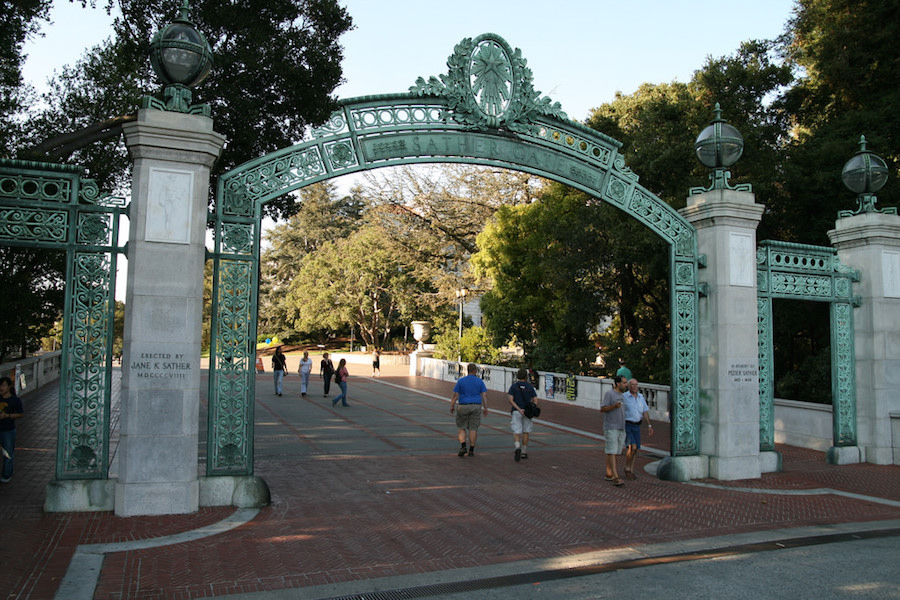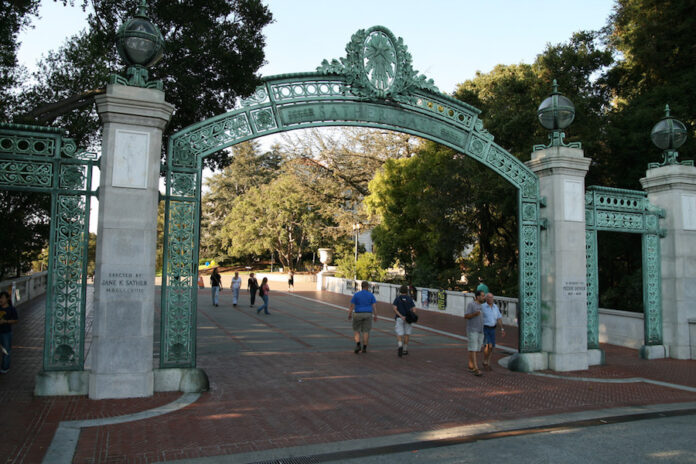
 Meet the man assiduously recording Berkeley’s past and present weirdness
Meet the man assiduously recording Berkeley’s past and present weirdness
Should it ever strike your fancy to Google the terms “bowling balls as lawn art,” “enormous dachshund sculptures,” “a pyramid made of birdhouses” or “a house in the shape of a tardigrade,” you’ll be delighted to find that all these oddities exist in the city limits of Berkeley. You’ll also be pleased to learn that one man has taken it upon himself to record all these and more, through photography and written word.
Tom Dalzell is the brains behind Quirky Berkeley, a website that, by anthologizing the eccentricities of the city’s material culture, is helping to preserve a cornerstone of American culture at one of the country’s most prominent public universities.
Dalzell’s prose is liberally peppered with allusions to high culture, the marks of his Ivy League education. A walk through Marcia Donahue’s garden for him inspires the same awe as “a walk into a Maybeck home.” He correctly identifies Marion Friedman’s backyard collection as a homage to “objet trouvé,” a French Surrealist movement. He devotes an entire section of his blog to the aesthetic of emptiness, inspired by the Buddhist philosophy of Sunyata.
But despite the erudition and knowledge which he possesses, Dalzell is incredibly skilled at connecting with his readers. As he guides his audience through the nuance of Berkeley’s quirks, he uses second-person pronouns to directly address the reader. To read his blog is to engage in tȇte-à-tȇte with a romantic on the subject of his lover. A reader who shares Dalzell’s love for quirk will find that his writing exudes a distinct warmth.
All this ran through my mind as I shivered under Dalzell’s cold glare. He had marshalled me to stand opposite his end of his kitchen island, and now sat in annoyed anticipation of my questions.
When Dalzell isn’t curating his quirk collection, he is managing the finances of the International Brotherhood of Electrical Workers (IBEW) California chapter. His career and hobby have shared a serendipitous connection throughout his life, as if labor lawyer and Berkeley enthusiast are in the same karass of occupations.
Back in 1968, when movies cost a nickel and the Beatles still crooned together, Dalzell travelled to Delano, California for a summer gig with the United Farm Workers. It was on a weekend excursion away from the Central Valley when Dalzell first laid eyes upon his city. Love at first sight? Not quite.
“I admit — it was a shock to my eyes,” Dalzell said. “It was more than I could absorb.”
Understandable. 1968 Berkeley was the city at its most extreme. This was the year of the Tet offensive, the Black Power takeover of Columbia, the assassinations of Martin Luther King Jr. and Bobby Kennedy, the student uprising in Paris, the politicized Mexico City Olympics, the bloody Democratic National Convention riots and Prague Spring. And the University of California’s famous student protesters had much to say about it all. To Dalzell, at the time a “just-barely-17 year old Mainline Philadelphia Episcopal” high schooler, the scene was overwhelming.
Yet he kept visiting Berkeley that summer. And after a five-semester stint at the University of Pennsylvania, he heard “the call to be part of social change,” returned to Delano to work for UFW, at one point even rubbing shoulders with Cesar Chavez. But he kept visiting Berkeley.
Our conversation to this point was still quite chilly. Dalzell’s expression this morning rested at a slight scowl. He periodically turned his back to me to wash dishes, sweep the kitchen counter and feed the feisty felines who kept mounting the kitchen island. When he did sit before me, his eye contact oscillated between the window behind me and the notepad in my hands. And he ended his rehearsed replies mid-thought, abruptly shooting his anticipant gaze back at me.
When I posed a more thought-provoking line of conversation (“What is the state of farmworkers today?”), Dalzell perked up. He stopped scrubbing mid-cereal bowl, planted himself firmly to his stool and abandoned his watch of my notebook. Something resembling a smile creeped onto his face, as he laid out a long intellectual indictment of the UFW’s current direction. And, once he finished, he finally acknowledged my presence by asking about my article.
An insight struck me harder than the Campanelli’s clapper strikes its mouth at noon. Dalzell’s cold exterior is not a product of rudeness or scorn. It is a deliberate investment decision, a choice to expend energy on refinement of mind and soul, instead of on the costly upkeep of conventional appearance and manner.
Tom Dalzell is a quintessential Berkeley Gentleman.
**
The idea that a city makes a man is not a novel one. Plato theorized that a city’s cycle of regimes would bring about different breeds of man — a timocracy would create a populace obsessed with an honor, an aristocracy a populace obsessed with wealth. In antebellum America, the Southern gentleman was warm, slow-speaking, mannered and hospitable on the outside, but brutal and flawed on the inside, akin to how the glamour of plantation life lightly coated the disgusting institution of slavery.
On first glance, Berkeley’s grey July skies, dilapidated old buildings and homeless-strewn sidewalks make it seem unwelcoming. Yet should you duck into one of those dingy old buildings, you’ll find likely yourself in a palatable ethnic restaurant, like Naan N Curry. Or in a brimming repository of used books and ideas, like Moe’s Books. Or in a cafe doubling as a hotbed of political debate, like the Caffe Mediterraneum.
Like his city, Tom Dalzell is a treasure trove of insightfulness on the inside. The secrets to digging through Dalzell’s rough exterior and meeting the worldly intellectual are patience and genuine interest.
**
Our conversation carried onward with a newfound energy. Dalzell quit the UFW in the late 1970s due to his aforementioned qualms with its direction. He decided to try his hand at the world’s second oldest profession, by moving to Sacramento and joining Jerry Brown’s ill-fated 1980 presidential campaign. Yes, Dalzell is acquainted with Governor Moonbeam as well.
The IBEW offered him a job in 1984 as the union’s counsel. IBEW’s office is in Walnut Creek, a sleepy suburb 25 miles east of San Francisco. So finally, circumstance permitted Dalzell to settle in his current home, an Edwardian townhouse in North Berkeley.
Dalzell, who sees himself as a flaneur, describes himself on his blog as “a perceptive urban stroller who [makes] aesthetically attuned observations.” Since his first visit to Berkeley, he’s made mental lists of the oddities he’s spotted on walks, but it was a pulmonary failure that led to a near-death experience in 2011 that imbued in him the mission of cataloging all the city’s quirks.
Implicit in his goal is the task of strolling down every block of Berkeley — its squalorous West, upper-class North, gentrifying South and student-tailored East.
His mission began with a focus on North Berkeley, and a result his entries are composed mostly of the eccentric backyard art and sidewalk installations of Berkeley old-timers. He has only recently started making headway into strolling through other parts of the city, and into documenting its past.
Just before I left, I rose to Dalzell an existential question, one that I imagined had given him many sleepless nights:
“What is Berkeley?”
Without a word, Dalzell stood up from his stool, but not to wash more dishes. He motioned for me to follow him through his memorabilia-adorned hallway (too quick for me to discern much, but I think I spotted a letter from Cesar Chavez, and a photo with Mario Savio) into his office. Amongst the clutter of notes and books on his desk is a stack of bright yellow paperbacks — the contents of his blog, condensed into a publication. He grabs one from the stack, opens it a third of the way through and points me to a short yet profound answer.
“Berkeley is a refuge from the rational culture.”
Written by: Sid Bagga — sidobagga@gmail.com
Disclaimer: The views and opinions expressed by individual columnists belong to the columnists alone and do not necessarily indicate the views and opinions held by The California Aggie.





